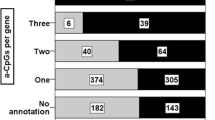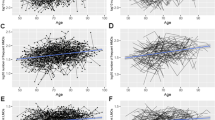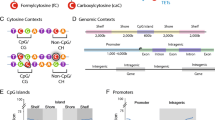Abstract
Aging is a process where individuals decrease the performance of their physiological systems and cellular stress response, making them more susceptible to disease and death. The increase in DNA damage associated with age might be recognized as the accumulation of physiological and environmentally induced mutations accompanied with a decline in DNA repair. DNA mismatch repair (MMR) is the main postreplicative correction pathway, which is known to decrease with age. However, since infrequent occurrence of direct DNA damage contrasts with the extensive cell and tissue dysfunction seen in older individuals, the withdrawing of DNA-repairing systems might be also related to epigenetic changes, such as DNA methylation. It has been reported that the physiological stress related to breeding might accelerate the acquisition of aging-related markers; therefore, the aim of this work was to link age with epigenetic modifications in this animal population. Hence, the correlation of Msh2 gene silencing with the deterioration of breeding female mice associated to aging was determined. Combined bisulfite restriction analysis assay was used to compare methylation on DNA isolated from twelve-month-old retired breeders against nulliparous female mice aged-matched, and two-month-old young adults. Our experiments clearly reveal Msh2 promoter hypermethylation associated to the aging process. A higher degree methylation was additionally observed in breeding females DNA. Nevertheless, this additional methylation did not correlate with a further decrease Msh2 mRNA, suggesting that the increase in methylation in old retired breeder might account for further epigenetic changes that could additionally promote the aging process.



Similar content being viewed by others
Abbreviations
- MMR:
-
DNA mismatch repair
- COBRA:
-
Combined bisulfite restriction analysis assay
References
Ahuja N, Issa JP (2000) Aging, methylation and cancer. Histol Histopathol 15:835–842
Akintola AD, Crislip ZL, Catania JM, Zimmer WE, Burgahrdt RC, Parrish AR (2007) Promoter methylation is associated with the age-dependent loss of N-cadherin in the rat kidney. Am J Physiol Renal Physiol (in press)
Altamirano A (1994) Manual de manejo de animales de laboratorio. Facultad de Estudios Superiores Veterinaria. Zaragoza UNAM, México
Bennett-Baker PE, Wilkowski J, Burke DT (2003) Age-associated activation of epigenetically repressed genes in the mouse. Genetics 165:2055–2062
Bernstein EE, Meissner A, Lander ES (2007) The mammalian epigenome. Cell 128:669–681
Bjornsson HT, Fallin MD, Feinberg AP (2004) An integrated epigenetic and genetic approach to common human disease. Trends Genet 20:350–358
Bohr VA (2002) Repair of oxidative DNA damage in nuclear and mitochondrial DNA, and some changes with aging in mammalian cells. Free Radic Biol Med 32:804–812
Campbell MR, Wang Y, Andrew SE, Liu Y (2006) MSH2 deficiency leads to chromosomal abnormalities, centrosome amplification, and telomere capping defect. Oncogene 25:2531–2536
Candore G, Balistreri CR, Listi F, Grimaldi MP, Vasto S, Colonna-Romano G, Franceschi C, Lio D, Caselli G, Caruso C (2006) Immunogenetics, gender, and longevity. Ann NY Acad Sci 1089:516–537
Chan PA, Duraisamy S, Miller PJ, Newell JA, McBride C, Bond JP, Raeveera T, Ollila S, Nyström M, Grimm AJ, Christodoulou J, Oetting WS, Greenbelatt MS (2007) Interpreting missense variants: comparing computational methods in human disease genes CDKN2A, MLH1, MSH2, MECP2, and tyrosinase (TYR). Hum Mutat 28:683–693
Chomczynski P (1993) A reagent for the single-step simultaneous isolation of RNA, DNA and proteins from cell and tissue samples. Biotechniques 15:532–537
Degtyareva NP, Greenwell P, Hofmann RE, Hengartner MO, Zhang L, Culotti JG, Petes TD (2002) Caenorhabditis elegans DNA mismatch repair gene msh-2 is required for microsatellite stability and maintenance of genome integrity. Proc Natl Acad Sci USA 99:2158–2163
Estes S, Phillips PC, Denver DR, Thomas WK, Lynch M (2004) Mutation accumulation in populations of varying size: the distribution of mutational effects for fitness correlates in Caenorhabditis elegans. Genetics 166:1269–1279
Feinberg AP, Oshimura M, Barrett JC (2002) Epigenetic mechanisms in human disease. Cancer Res 62:6784–6787
Finch CE, Pike MC, Witten M (1990) Slow mortality rate accelerations during aging in some animals approximate that of humans. Science 249:902–905
Fraga MF, Agrelo R, Esteller M (2007) Cross-talk between aging and cancer: the epigenetic language. Ann NY Acad Sci 1100:60–74
Garcia-Manero G, Daniel J, Smith TL, Kornblau SM, Lee MS, Kantarjian HM, Issa JP (2002) DNA methylation of multiple promoter-associated CpG islands in adult acute lymphocytic leukemia. Clin Can Res 8:2217–2224
Goldberg M, Rummelt C, Laerm A, Helmbold P, Holbach LM, Ballhausen WG (2006) Epigenetic silencing contributes to frequent loss of the fragile histidine triad tumour suppressor in basal cell carcinomas. Br J Dermatol 155:1154–1158
Grunau C, Sanchez C, Ehrlich M, Van der Bruggen P, Hindermann W, Rodriguez C, Krieger S, Dubeau L, Fiala E, De Sario A (2005) Frequent DNA hypomethylation of human juxtacentromeric BAGE loci in cancer. Genes Chrom Cancer 43:11–24
Harfe BD, Jinks-Robertson S (2000) Sequence composition and context effects on the generation and repair of frameshift intermediates in mononucleotide runs in Saccharomyces cerevisiae. Genetics 156:571–578
Hasty P, Vijg J (2002) Aging. Genomic priorities in aging. Science 296:1250–1251
Hughes S, Jones LJ (2007) The use of whole genome amplified DNA as a control for methylation specific PCR, pyrosequencing, bisulfite sequencing and methylation-sensitive restriction enzyme PCR. BMC Mol Biol 8(1):91
Imam SZ, Karahalil B, Hogue BA, Souza-Pinto NC, Bohr VA (2006) Mitochondrial and nuclear DNA-repair capacity of various brain regions in mouse is altered in an age-dependent manner. Neurobiol Aging 27:1129–1136
Issa JP (2002) Epigenetic variation and human disease. J Nutr 132:2388S–2392S
Issa JP (2003) Age-related epigenetic changes and the immune system. Clin Immunol 109:103–108
Issa JP (2007) DNA Methylation in cancer protocols. Bisulfite-PCR for Restriction Analysis and/or Sequencing. http://www.mdanderson.org/departments/methylation/display. Cited 11 Dic 2007. The University of Texas MD Anderson Cancer Center.
Jiricny J (2006) The multifaceted mismatch-repair system. Nature Rev 7:335–346
Jun S, Kim TG, Ban C (2006) DNA mismatch repair system classical and fresh roles. FEBS J 273:1609–1619
Kim JY, Siegmund KD, Tavaté S, Shibata D (2005) Age-related human small intestine methylation: evidence for stem cell niches. BMC Med 3:10
Königsberg M, López-Diazguerrero NE, Rivera-Martinez LP, González-Puertos VY, González-Vieira R, Gutiérrez-Ruiz MC, Zentella A (2007) The physiological deterioration associated to breeding in female mice: a model for the study of senescence and aging. Comp Biochem Physiol A 146:695–701
López-Araiza H, Ventura JL, López-Diazguerrero NE, González-Marquez H, Gutiérrez-Ruíz MC, Zentella DA, Königsberg FM (2006) Organ- and Tissue-specific Alterations in the Anti-apoptotic Protein Bcl-2 in CD1 Female Mice of Different Ages. Biogerontology 7:63–67
López-Diazguerrero NE, Luna-López A, Gutiérrez-Ruiz MC, Zentella A, Konigsberg M (2005) Susceptibility of DNA to oxidative stressors in young and aging mice. Life Sci 77:2840–2854
Madia F, Gattazzo C, Fabrizio P, Longo VD (2007) A simple model system for age-dependent DNA damage and cancer. Mech Ageing Dev 128:45–49
Matos HR, Capelozzi VL, Gomes OF, Di Mascio P, Medeiros MH (2001) Lycopene inhibits DNA damage and liver necrosis in rats treated with ferric nitiolacetate. Arch Biochem Biophys 396:171–177
Matsuo K, Silke J, Gramatikoff K, Schaffner W (1994) The CpG-specific methylase SssI has topoisomerase activity in the presence of Mg2+. Nucleic Acids Res 22:5354–4359
Neri S, Pawelec G, Facchini A, Mariani E (2007) Microsatellite instability and compromised mismatch repair gene expression during in vitro passaging of monoclonal human T lymphocytes. Rejuvenation Res 10:145–156
Ottaviano Y, Issa JP, Parl FF, Smith HS, Baylin SB, Davidson NE (1994) Methylation of the estrogen receptor gene CpG island marks loss of estrogen receptor expression in human breast cancer cells. Cancer Res 54:2552–2555
Park Y, Gerson SL (2005) DNA repair defects in stem cell function and aging. Ann Rev Med 56:495–508
Phelan JP, Rose MR (2005) Why dietary restriction substantially increases longevity in animal models but won’t in humans. Age Res Rev 4:339–350
Ravindran CR, Ticku MK (2005) Methylation of NMDA receptor NR2B gene as a function of age in the mouse brain. Neurosci Lett 380:223–228
Richardson B (2003) Impact of aging on DNA methylation. Age Res Rev 2:245–261
Rossi DJ, Bryder D, Seita J, Nussenzweig A, Hoeijmarkers J, Wisseman IL (2007) Deficiencies in DNA damage repair limit the function of haematopoietic stem cells with age. Nature 447:725–729
Russel ES (1964) Lifespan and aging patterns. In: Green EL (ed) Biology of the Laboratory Mouse. Dover Publications. Inc., New York, pp 685–692
Schmitt E, Paquet C, Beauchemin M, Bertrand R (2007) DNA-damage response network at the crossroads of cell-cycle checkpoints, cellular senescence and apoptosis. J Zhejiang Univ Sci B 8:377–397
Siegmund KD, Connor CM, Campan M, Long TI, Weisenberg DJ, Biiniskiewicz D, Jeanish R, Laird PW, Akbarian S (2007) DNA methylation in the human cerebral cortex is dynamically regulated throughout the life span and involves differentiated neurons. PLoS ONE 2(9):e895
So K, Tamura G, Honda T, Homma N, Waki T, Togawa N, Nishizuka S, Motoyama T (2006) Multiple tumor suppressor genes are increasingly methylated with age in non-neoplastic gastric epithelia. Cancer Sci 97:1155–1158
Takahashi Y, Moriwaki S, Sugiyama Y, Endo Y, Yamazaki K, Mori T, Takigawa M, Inoue S (2005) Decreased gene expression responsible for post-ultraviolet DNA repair synthesis in aging: a possible mechanism of age-related reduction in DNA repair capacity. J Inv Dermatol 124:435–442
Tuirán R, Partida V, Mojarro O, Zúñiga E (2002) Tendencias y perspectivas de la fecundidad. La Situación Demográfica de México. Consejo Nacional de Población (CONAPO). México City, pp 29–48
Villarreal-Molina MT, Aguilar-Salinas CA, Rodrıguez-Cruz M, Riano D, Villalobos-Comparan M, Coral-Vazquez R, Menjivar M, Yescas-Gomez P, Konigsoerg-Fainstein M, Romero-Hidalgo S, Tusie-Luna MT, Canizales-Quinteros S (2007) The ATP-binding cassette transporter A1 R230C variant affects HDL cholesterol levels and BMI in the Mexican population. Diabetes 56:1881–1887
Wang L, Hirayasu K, Ishisawa M, Kobayash Y (1994) Purification of genomic DNA from human whole blood by isopropanol-fractionation with concentrated Nal and SDS. Nucl Acids Res 22:1774–1775
Xiong Z, Laird PW (1997) COBRA: a sensitive and quantitative DNA methylation assay. Nucleic Acids Res 25:2532–2534
Xu XL, Yu J, Zhang HY, Sun MH, Gu J, Du X, Shi DR, Wang P, Yang ZH, Zhu JD (2004) Methylation profile of the promoter CpG islands of 31 genes that may contribute to colorectal carcinogenesis. World J Gastroenterol 10:3441–3454
Yang AS, Estécio MRH, Doshi K, Kondo Y, Tajara EH, Issa JP (2004) A simple method for estimating global DNA methylation using bisulfite PCR of repetitive DNA elements. Nucl Acids Res 32:1–6
Yuasa Y (2002) DNA methylation in cancer and ageing. Mech Ageing Dev 123:1649–1654
Zeng X, Kinsella TJ (2007) A novel role for DNA mismatch repair and the autophagic processing of chemotherapy drugs in human tumor cells. Autophagy 3:368–370
Zúñiga E, Durán D, Logia S (2002) La salud reproductiva en las entidades federativas: una mirada a través de los índices de rezago. La Situación Demográfica de México. Consejo Nacional de Población (CONAPO). Mexico City, pp 49–66.
Zurcher C, Van Zwieten MJ, Solleveld HA, Hollander CF (1982) The mouse in biomedical research. In: Foster HL, Small JD, Fox JG (eds) Experimental biology and oncology, Inc. New York, Academic Press, pp 325–345
Acknowledgments
The authors would like to thank R. González-Vieira MVZ who cared for the animals, Dr. FJ Perrino (UAMI) and Dr. MT Villarreal-Molina (INCMNSZ) for their help with the molecular biology and sequencing techniques. We also want to thank Dr. JP Issa and Drs. Wombak and Kroeger from the University of Texas M. D. Anderson Cancer Center for their guidance in the COBRA methodology. This work was supported by CONACyT′s grant CB-2006-1-59659. JC Conde-Pérezprina and A Luna-López are CONACYT scholarship holders.
Author information
Authors and Affiliations
Corresponding author
Rights and permissions
About this article
Cite this article
Conde-Pérezprina, J.C., Luna-López, A., López-Diazguerrero, N.E. et al. Msh2 promoter region hypermethylation as a marker of aging-related deterioration in old retired female breeder mice. Biogerontology 9, 325–334 (2008). https://doi.org/10.1007/s10522-008-9144-8
Received:
Accepted:
Published:
Issue Date:
DOI: https://doi.org/10.1007/s10522-008-9144-8




